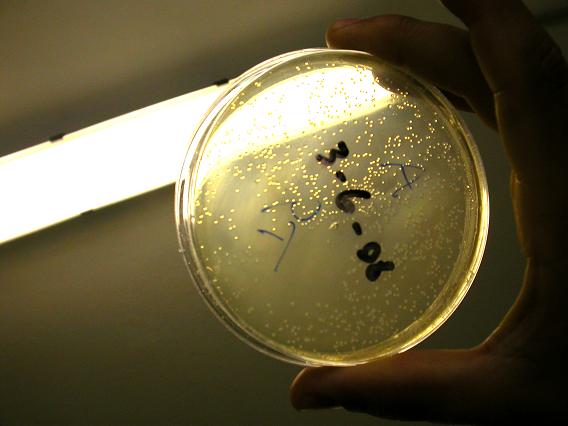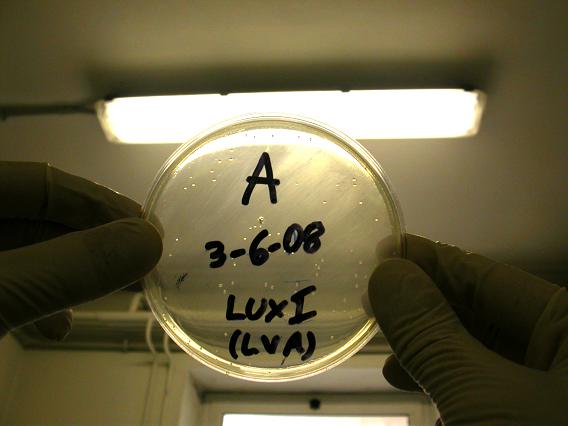Team:UNIPV-Pavia/Notebook/Week3
From 2008.igem.org
Notebook
| Week 1 | Week 2 | Week 3 | Week 4 | Week 5 | Week 6 | Week 7 |
|---|
Week 3: 06/03/08 - 06/06/08
06/03/08
- We transformed 60 µl of TOP10 with 2 µl of the 6 parts (DNA + glycerol) we received from IGEM HQ:
| BBa_C0179 | BBa_C0161 | BBa_R0051 | BBa_I14032 |
| BBa_I15008 | BBa_I15010 |
- NOTE: We noticed that IGEM 2007 teams which used luxI or lasR parts choosed BBa_C0061 instead of BBa_C0161 and BBa_C0079 instead of BBa_C0179. So, we decided in addition to amplify BBa_C0061 and BBa_C0079; we shall see later which luxI and lasR to choose.
- So, we cut paper spots for BBa_C0061 and BBa_C0079 and resuspended them in 10 µl of warmed TE buffer.
- We transformed these 2 parts using 4 µl of DNA in TE.
- We plated transformed bacteria and incubated them at 37°C overnight.
06/04/08
- After overnight incubation, the following 5 plates showed colonies:
|
|
|
- while the following 3 plates did not:
| BBa_C0079 | BBa_C0179 |
| BBa_C0161 |
- We repeated the transformation for BBa_C0079, BBa_C0179 and C0161. We used 6 µl of DNA in TE for BBa_C0179, while we used 3 µl of DNA + glycerol for BBa_C0079 and BBa_C0161.
- We plated transformed bacteria and incubated them at 37°C overnight.
- While we were preparing our 5 ml cultures, we noticed that LB + Amp was contaminated! We decided to prepare a big quantity of LB + Amp and also of LB + Kan: we prepared 0.5 l LB + Amp and 0.5 l LB + Kan for liquid cultures; 0.5 l LB + Amp and 0.5 l LB + Kan for plates.
- We picked up one colony from BBa_C0061, BBa_R0051, BBa_I14032, I15008 and I15010 plates to grow 5 ml cultures of transformed bacteria overnight.
- We also infected 5 ml of LB + Amp with 15 µl of BBa_B0030 glycerol stock. We incubated the 5 ml cultures overnight at 37°C.
- We received QIAGEN QIAprep Spin Miniprep Kit!!! We will inaugurate it tomorrow on these 5 ml cultures;)
06/05/08
- We received Euroclone Antartic Phosphatase: we will use it in the afternoon!
- We prepared 14 glycerol stocks taking 800 µl from 5 ml cultures containing:
| BBa_R0051 | BBa_I15008 | BBa_I15010 | BBa_I14032 |
| BBa_C0061 | BBa_B0030 |
- We performed miniprep for these 6 parts with our new splendid kit;) Plasmid quantification confirmed a higher yield than our previous QIAGEN kit.
- We performed plasmid digestion for these parts (20 of 30 µl).
- We had to insulate excided fragments for:
| BBa_I15008 (X-P) | BBa_I15010 (X-P) | BBa_I14032 (X-P) | BBa_C0061 (X-P) |
| BBa_B0030 (X-P) |
- While we had to insulate opened plasmids for:
| BBa_R0051 (S-P) |
- Due to the different dimension of the DNA we had to insulate, we ran 3 different gels:
- one for BBa_R0051 (S-P)
- one for BBa_I14032 (X-P)
- one for BBa_C0061 (X-P), BBa_I15008 (X-P), BBa_I15010 (X-P), BBa_B0030 (X-P).
- Unfortunately, BBa_B0030 (X-P) and BBa_J23100 (E-S) fragments had smearing appearance because they were smaller than other excided fragments and ran too fast.
- We performed gel extraction for all the 9 parts, but we decided to repeat cutting/run/extraction process for BBa_B0030 (X-P) and BBa_J23100 (E-S) in the next days, to perform a more efficient extraction for these 2 parts.
 "
"


